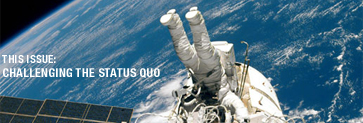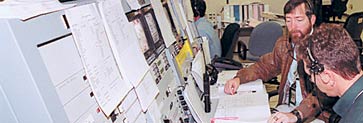Hector Delgado
How do you reallocate funds without people feeling like you’re taking away “their money”? If the money is being used efficiently, reallocation is a moot point; but if efficiency is not the case in your organization, you’ve got a corrosive situation that must be addressed.
At the Kennedy Space Center we needed to find a process by which all the sacred cows could be identified. Given the legacy of the organization, it was clear that one possible solution would be to adopt an “Inclusion Solution” to the process. That is, have our customers, developers, and contractors included in the process, so that they would feel this was not just an exercise to take away “their money.”
I attempted to do just that in 1999 when I transferred to the Engineering Development Directorate at KSC. I was asked to head the Development Project office. I viewed it as an opportunity to shake up the system — because, in my view, this was a system badly in need of shaking up.
Here’s what I’m getting at. Picture this: KSC’s career engineer returns home from work at the end of the day and is greeted by a spouse who asks, ‘So, Honey, what did you do today?’ The engineer replies, ‘Oh, it was just like any other day. I watched.’
Watching, I’m afraid, has become all too commonplace at KSC. It seems like most of our career engineers are getting paid to watch contractors do the hands-on engineering work — what at one time we were doing in our own labs, we now are delegating to people outside the agency. Sure we provide insight, and I don’t have any problem with that,but the future for the career engineer at KSC did not look very bright in 1999. Many were asking themselves, “Am I going to become obsolete?”
The situation had to change because for an institution to survive and flourish, it has to use the talent within (otherwise you threaten the very existence of the institution). There were plenty of talented NASA people whose boredom and frustration would eventually undermine the promise of what NASA originally meant — exciting, cutting-edge, hands-on engineering work. To lose the talent within an institution like NASA is in essence to kill it. What kind of institution do you have when there is no institutional memory? Facilities remain standing, but the lifeblood inside has been pumped dry.
In my new job, therefore, I considered it the first order of business to find ways to come up with funding for new development activities for the career engineers at KSC. Historically, the Engineering Technology Base (ETB) budget was used for operational support of core capabilities as well as program support.
I wanted to use my position to put new projects back in the hands of our civil servants. I believe the opportunity to branch out into other projects and research is upon us, especially as the shuttle program relinquishes more of the day-to-day processing responsibility to the private sector, but it is up to us to seize this opportunity while it lasts. To do so would require looking at all of our current projects and deciding which ones to jettison to make room for reinvestment.
My strategy was simple. I needed to convey that diversification and re-investment did not mean taking away “their money.” Instead, I wanted people to see that this was a realignment of “our” resources, and this process belonged to all. Getting them to see this was going to be the tough part. Naturally, you have to use dialogue — which isn’t easy, because remember, engineers want solutions, not talk.
My team consisted of myself and two other KSC veterans, David Collins and Oscar Toledo. We started by being there all the time. And we were, ladies and gentleman, until late at night, every night. You’ve heard the expression “Build it and they will come.” In our case it was “Open the door and they will come.”
“You can’t reallocate this money — the project will come to a standstill, we won’t be able to launch. And besides, it’s MY money!”
We heard them out to the bitter end. At every opportunity, we explained why we were doing this. Besides the fact that we were all going to lose our jobs if we didn’t change, we talked about realigning with our customers’ needs, developing technology to support present and future needs, providing more opportunities for civil servants to participate in hands-on development activities. We talked and we talked until we felt like we had these lines memorized and were saying them in our sleep.
Another important part of the strategy was to put together a team that would look at how all project money was being spent at the center. The team consisted of division chiefs, project managers, customers, and contractors. We reviewed all of the projects and found that a number of them were inactive. The projects were cancelled, or the project managers were given the chance to reclaim them. Few did, incidentally.
The process progressed to a line-by-line review of every project, every budget, and every procurement at the center. It sounds time consuming, and it is, but this was absolutely necessary. We brought together the customer, the developer, and, where applicable, the contractor to have an open and meaningful discussion about every project, and gave those with a vital stake in that project a chance to defend it.
Over several months, we dismantled and reassembled the entire budget. In order to obtain final buy-in from everyone, we held a project review with customers, developers and contractors. We scheduled the meeting at the Beach House — a mini-conference center at KSC used by senior management for retreats — to make sure that everyone was feeling good and loose before the fur started flying.
It wasn’t nearly that bad, however. In fact, it was fun, it was stimulating, and in the end there were no broken bones or bloody noses.
Together, we identified ten technical product areas for investment and partnering with different programs and private industry. The “my money” attitude had magically transformed into “our money.” And “our money” resulted in a development budget of $2.2 million in new investments in applied research and an additional $1 million in laboratory capital.
By creating a process that was driven by inclusion, open dialogue and clearly defined goals, the team realized an outcome that managed to overcome deeply entrenched norms and suspicion. We had to go about it like this because we were challenging years of tradition, radicalizing a “business-as-usual” mentality. Not everyone at KSC was enamored of our work. A significant number of people at the Center couldn’t wait for me to find another job. When you challenge people to change, sometimes the only reaction you get is a steadfast resistance to change. But let’s not leave off like this — for that’s only one reading. The majority of people at our Center, I believe, are much happier, prouder, and feeling good about their future. At KSC we now watch a lot less and do a good deal more of the work we came here for in the first place. For those of us at KSC who prefer to read the story this way, sharing risk, responsibilities and ownership has been a tremendous success.
Lessons
- Persistence pays off — if you are not willing to go ALL the way, you better not start.
- Be inclusive, even if it takes more time. People will lower their defenses when they know they are being heard.
- Put together a team to lead the change. The entire team must understand the situation and be able to articulate a unified message.
Search by lesson to find more on:
- Challenging the Status Quo
- Change
- Budgets









